Estevam Hruschka
Towards Reliable Benchmarking: A Contamination Free, Controllable Evaluation Framework for Multi-step LLM Function Calling
Sep 30, 2025
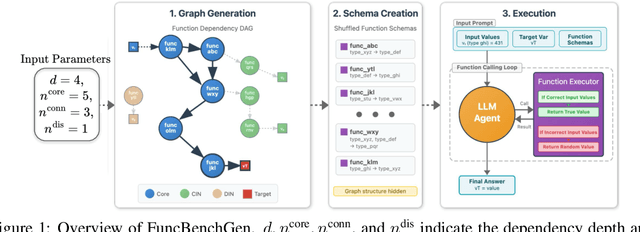


Abstract:As language models gain access to external tools via structured function calls, they become increasingly more capable of solving complex, multi-step tasks. However, existing benchmarks for tool-augmented language models (TaLMs) provide insufficient control over factors such as the number of functions accessible, task complexity, and input size, and remain vulnerable to data contamination. We present FuncBenchGen, a unified, contamination-free framework that evaluates TaLMs by generating synthetic multi-step tool-use tasks. The key idea is to cast tool use as traversal over a hidden function-dependency DAG where nodes are function calls and an edge between nodes represents one function consuming the output of another. Given a set of external function schemas, initial variable values, and a target variable, models must compose the correct call sequence to compute the target variable. FuncBenchGen allows users to precisely control task difficulty (e.g., graph size, dependency depth, and distractor functions) while avoiding data leakage. We apply our FuncBenchGen framework to evaluate seven LLMs on tool use tasks of varying difficulty. Reasoning-optimized models consistently outperform general-purpose models with GPT-5 significantly outperforming other models. Performance declines sharply as dependency depth increases. Furthermore, connected irrelevant functions prove especially difficult to handle. We find that strong models often make syntactically valid function calls but propagate incorrect or stale argument values across steps, revealing brittle state tracking by LLMs in multi-turn tool use. Motivated by this observation, we introduce a simple mitigation strategy that explicitly restates prior variable values to the agent at each step. Surprisingly, this lightweight change yields substantial gains across models. e.g., yielding a success rate improvement from 62.5% to 81.3% for GPT-5.
Towards Probabilistic Question Answering Over Tabular Data
Jun 25, 2025Abstract:Current approaches for question answering (QA) over tabular data, such as NL2SQL systems, perform well for factual questions where answers are directly retrieved from tables. However, they fall short on probabilistic questions requiring reasoning under uncertainty. In this paper, we introduce a new benchmark LUCARIO and a framework for probabilistic QA over large tabular data. Our method induces Bayesian Networks from tables, translates natural language queries into probabilistic queries, and uses large language models (LLMs) to generate final answers. Empirical results demonstrate significant improvements over baselines, highlighting the benefits of hybrid symbolic-neural reasoning.
Mixed Signals: Decoding VLMs' Reasoning and Underlying Bias in Vision-Language Conflict
Apr 11, 2025Abstract:Vision-language models (VLMs) have demonstrated impressive performance by effectively integrating visual and textual information to solve complex tasks. However, it is not clear how these models reason over the visual and textual data together, nor how the flow of information between modalities is structured. In this paper, we examine how VLMs reason by analyzing their biases when confronted with scenarios that present conflicting image and text cues, a common occurrence in real-world applications. To uncover the extent and nature of these biases, we build upon existing benchmarks to create five datasets containing mismatched image-text pairs, covering topics in mathematics, science, and visual descriptions. Our analysis shows that VLMs favor text in simpler queries but shift toward images as query complexity increases. This bias correlates with model scale, with the difference between the percentage of image- and text-preferred responses ranging from +56.8% (image favored) to -74.4% (text favored), depending on the task and model. In addition, we explore three mitigation strategies: simple prompt modifications, modifications that explicitly instruct models on how to handle conflicting information (akin to chain-of-thought prompting), and a task decomposition strategy that analyzes each modality separately before combining their results. Our findings indicate that the effectiveness of these strategies in identifying and mitigating bias varies significantly and is closely linked to the model's overall performance on the task and the specific modality in question.
Orchestrating Agents and Data for Enterprise: A Blueprint Architecture for Compound AI
Apr 10, 2025Abstract:Large language models (LLMs) have gained significant interest in industry due to their impressive capabilities across a wide range of tasks. However, the widespread adoption of LLMs presents several challenges, such as integration into existing applications and infrastructure, utilization of company proprietary data, models, and APIs, and meeting cost, quality, responsiveness, and other requirements. To address these challenges, there is a notable shift from monolithic models to compound AI systems, with the premise of more powerful, versatile, and reliable applications. However, progress thus far has been piecemeal, with proposals for agentic workflows, programming models, and extended LLM capabilities, without a clear vision of an overall architecture. In this paper, we propose a 'blueprint architecture' for compound AI systems for orchestrating agents and data for enterprise applications. In our proposed architecture the key orchestration concept is 'streams' to coordinate the flow of data and instructions among agents. Existing proprietary models and APIs in the enterprise are mapped to 'agents', defined in an 'agent registry' that serves agent metadata and learned representations for search and planning. Agents can utilize proprietary data through a 'data registry' that similarly registers enterprise data of various modalities. Tying it all together, data and task 'planners' break down, map, and optimize tasks and queries for given quality of service (QoS) requirements such as cost, accuracy, and latency. We illustrate an implementation of the architecture for a use-case in the HR domain and discuss opportunities and challenges for 'agentic AI' in the enterprise.
Insight-RAG: Enhancing LLMs with Insight-Driven Augmentation
Mar 31, 2025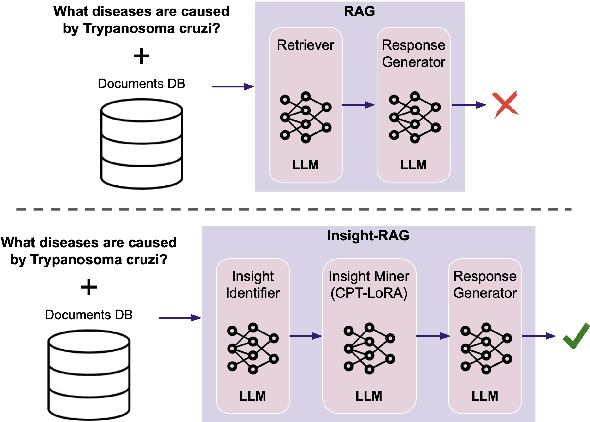

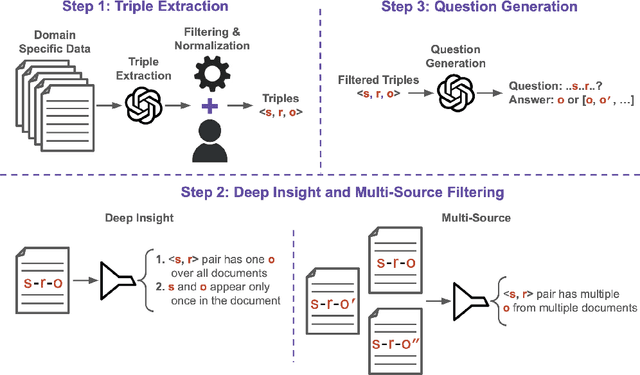

Abstract:Retrieval Augmented Generation (RAG) frameworks have shown significant promise in leveraging external knowledge to enhance the performance of large language models (LLMs). However, conventional RAG methods often retrieve documents based solely on surface-level relevance, leading to many issues: they may overlook deeply buried information within individual documents, miss relevant insights spanning multiple sources, and are not well-suited for tasks beyond traditional question answering. In this paper, we propose Insight-RAG, a novel framework designed to address these issues. In the initial stage of Insight-RAG, instead of using traditional retrieval methods, we employ an LLM to analyze the input query and task, extracting the underlying informational requirements. In the subsequent stage, a specialized LLM -- trained on the document database -- is queried to mine content that directly addresses these identified insights. Finally, by integrating the original query with the retrieved insights, similar to conventional RAG approaches, we employ a final LLM to generate a contextually enriched and accurate response. Using two scientific paper datasets, we created evaluation benchmarks targeting each of the mentioned issues and assessed Insight-RAG against traditional RAG pipeline. Our results demonstrate that the Insight-RAG pipeline successfully addresses these challenges, outperforming existing methods by a significant margin in most cases. These findings suggest that integrating insight-driven retrieval within the RAG framework not only enhances performance but also broadens the applicability of RAG to tasks beyond conventional question answering.
Evaluating Bias in LLMs for Job-Resume Matching: Gender, Race, and Education
Mar 24, 2025Abstract:Large Language Models (LLMs) offer the potential to automate hiring by matching job descriptions with candidate resumes, streamlining recruitment processes, and reducing operational costs. However, biases inherent in these models may lead to unfair hiring practices, reinforcing societal prejudices and undermining workplace diversity. This study examines the performance and fairness of LLMs in job-resume matching tasks within the English language and U.S. context. It evaluates how factors such as gender, race, and educational background influence model decisions, providing critical insights into the fairness and reliability of LLMs in HR applications. Our findings indicate that while recent models have reduced biases related to explicit attributes like gender and race, implicit biases concerning educational background remain significant. These results highlight the need for ongoing evaluation and the development of advanced bias mitigation strategies to ensure equitable hiring practices when using LLMs in industry settings.
Learning Beyond the Surface: How Far Can Continual Pre-Training with LoRA Enhance LLMs' Domain-Specific Insight Learning?
Jan 29, 2025Abstract:Large Language Models (LLMs) have demonstrated remarkable performance on various tasks, yet their ability to extract and internalize deeper insights from domain-specific datasets remains underexplored. In this study, we investigate how continual pre-training can enhance LLMs' capacity for insight learning across three distinct forms: declarative, statistical, and probabilistic insights. Focusing on two critical domains: medicine and finance, we employ LoRA to train LLMs on two existing datasets. To evaluate each insight type, we create benchmarks to measure how well continual pre-training helps models go beyond surface-level knowledge. We also assess the impact of document modification on capturing insights. The results show that, while continual pre-training on original documents has a marginal effect, modifying documents to retain only essential information significantly enhances the insight-learning capabilities of LLMs.
FactLens: Benchmarking Fine-Grained Fact Verification
Nov 08, 2024



Abstract:Large Language Models (LLMs) have shown impressive capability in language generation and understanding, but their tendency to hallucinate and produce factually incorrect information remains a key limitation. To verify LLM-generated contents and claims from other sources, traditional verification approaches often rely on holistic models that assign a single factuality label to complex claims, potentially obscuring nuanced errors. In this paper, we advocate for a shift toward fine-grained verification, where complex claims are broken down into smaller sub-claims for individual verification, allowing for more precise identification of inaccuracies, improved transparency, and reduced ambiguity in evidence retrieval. However, generating sub-claims poses challenges, such as maintaining context and ensuring semantic equivalence with respect to the original claim. We introduce FactLens, a benchmark for evaluating fine-grained fact verification, with metrics and automated evaluators of sub-claim quality. The benchmark data is manually curated to ensure high-quality ground truth. Our results show alignment between automated FactLens evaluators and human judgments, and we discuss the impact of sub-claim characteristics on the overall verification performance.
Natural Language Processing for Human Resources: A Survey
Oct 21, 2024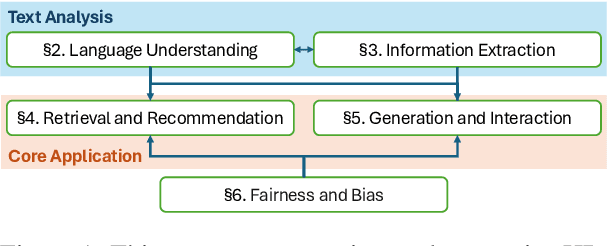
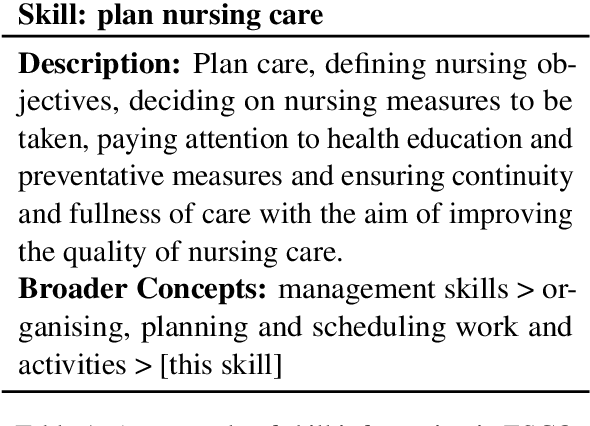


Abstract:The domain of human resources (HR) includes a broad spectrum of tasks related to natural language processing (NLP) techniques. Recent breakthroughs in NLP have generated significant interest in its industrial applications in this domain and potentially alleviate challenges such as the difficulty of resource acquisition and the complexity of problems. At the same time, the HR domain can also present unique challenges that drive state-of-the-art in NLP research. To support this, we provide NLP researchers and practitioners with an overview of key HR tasks from an NLP perspective, illustrating how specific sub-tasks (e.g., skill extraction) contribute to broader objectives (e.g., job matching). Through this survey, we identify opportunities in NLP for HR and suggest directions for future exploration.
From Single to Multi: How LLMs Hallucinate in Multi-Document Summarization
Oct 17, 2024



Abstract:Although many studies have investigated and reduced hallucinations in large language models (LLMs) for single-document tasks, research on hallucination in multi-document summarization (MDS) tasks remains largely unexplored. Specifically, it is unclear how the challenges arising from handling multiple documents (e.g., repetition and diversity of information) affect models outputs. In this work, we investigate how hallucinations manifest in LLMs when summarizing topic-specific information from multiple documents. Since no benchmarks exist for investigating hallucinations in MDS, we use existing news and conversation datasets, annotated with topic-specific insights, to create two novel multi-document benchmarks. When evaluating 5 LLMs on our benchmarks, we observe that on average, up to 75% of the content in LLM-generated summary is hallucinated, with hallucinations more likely to occur towards the end of the summaries. Moreover, when summarizing non-existent topic-related information, gpt-3.5-turbo and GPT-4o still generate summaries about 79.35% and 44% of the time, raising concerns about their tendency to fabricate content. To understand the characteristics of these hallucinations, we manually evaluate 700+ insights and find that most errors stem from either failing to follow instructions or producing overly generic insights. Motivated by these observations, we investigate the efficacy of simple post-hoc baselines in mitigating hallucinations but find them only moderately effective. Our results underscore the need for more effective approaches to systematically mitigate hallucinations in MDS. We release our dataset and code at github.com/megagonlabs/Hallucination_MDS.
 Add to Chrome
Add to Chrome Add to Firefox
Add to Firefox Add to Edge
Add to Edge